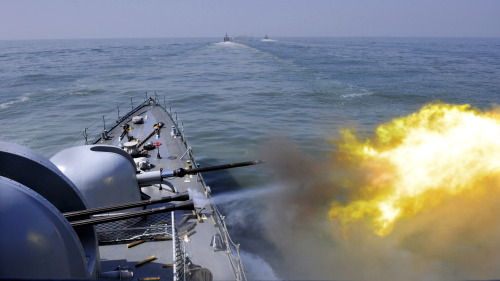Navy boosts anti-sub capabilities in wake of Cheonan
By Korea HeraldPublished : March 25, 2012 - 17:42
New equipment and tougher training enhances response to underwater threats
On March 26, 2010, North Korea carried out a torpedo attack on the South Korean corvette Cheonan, which sank off the coast of the northwestern island of Baengnyeong, taking with it 46 sailors.
Since then, the South Korean Navy has updated its patrol combat corvettes, increased anti-submarine exercises in the West Sea and made changes to its operations to better prepare for submarine attacks.
Previous to the incident the Navy’s anti-submarine efforts were mostly concentrated in the East Sea, the deeper waters of which provide a more suitable environment for submarine operations. According to Navy officials, the West Sea’s shallow waters limit submarine operation to depths of between 60 and 80 meters.
Despite such restrictions the West Sea presents for submarines, the attack on Cheonan showed that North Korean submarines were capable of operating in the area.
As such, the South Korean Navy has made changes ranging from updating equipment and increasing drills to establishing new posts in the chain of command and changing the pattern of vessel deployment.
“In the past, a patrol combat corvette would maneuver alone. Now, a corvette is coupled with a destroyer,” a Navy public relations officer said.
“Different types of vessels that can compliment each other were grouped to increase efficiency, and a destroyer also has anti-air capabilities.”
On March 26, 2010, North Korea carried out a torpedo attack on the South Korean corvette Cheonan, which sank off the coast of the northwestern island of Baengnyeong, taking with it 46 sailors.
Since then, the South Korean Navy has updated its patrol combat corvettes, increased anti-submarine exercises in the West Sea and made changes to its operations to better prepare for submarine attacks.
Previous to the incident the Navy’s anti-submarine efforts were mostly concentrated in the East Sea, the deeper waters of which provide a more suitable environment for submarine operations. According to Navy officials, the West Sea’s shallow waters limit submarine operation to depths of between 60 and 80 meters.
Despite such restrictions the West Sea presents for submarines, the attack on Cheonan showed that North Korean submarines were capable of operating in the area.
As such, the South Korean Navy has made changes ranging from updating equipment and increasing drills to establishing new posts in the chain of command and changing the pattern of vessel deployment.
“In the past, a patrol combat corvette would maneuver alone. Now, a corvette is coupled with a destroyer,” a Navy public relations officer said.
“Different types of vessels that can compliment each other were grouped to increase efficiency, and a destroyer also has anti-air capabilities.”

In addition to pairing corvettes with larger destroyers, the Navy has added the post of vice commander to squadrons to lessen the burden on the commanders of squadron-level units.
In terms of exercises, ships of the Second Fleet have been subjected to an unprecedented level of anti-submarine drills.
“The Second Fleet conducts anti-submarine drills at random intervals, and the drills do not follow predetermined scenarios,” said Commander Hong Jeong-an, the captain of the corvette Yeongju. Yeongju is a warship of the same class as the Cheonan and took part in a drill in the West Sea on Wednesday.
“Vessels that are already at sea when an exercise is conducted take part without any prior information. We maintain anti-submarine readiness around the clock.”
In terms of equipment, the corvettes have been given new anti-torpedo equipment and their solar equipment has been refurbished to restore its efficacy.
All corvettes now carry torpedo acoustic counter measure or TACM equipment. All corvettes now carry 24, 12 on each side, TACM rounds.
When a torpedo is detected, the TACM rounds are fired into the sea up to 800 meters away from the ship. The rounds then emit sounds louder than that of the ship in order to attract acoustic torpedoes away from the vessel.
In addition, the new equipment is capable of automatically calculating the timing and direction of evasive maneuvers as well as the angle at which the TACM rounds need to be fired for maximum effect.
According to the Navy, the sonar fitted in the corvettes is hull-mounted making it necessary for the entire hull to be changed for the sonar to be upgraded.
As such, the Navy improvised by replacing all of the parts found in the current equipment with newly-manufactured parts, restoring its original efficacy.
“In the past, we could not identify the sound made by enemy torpedoes. Now we can not only detect and identify the sound but the TACM equipment allows evasion,” Hong said.
The Navy says that such efforts have greatly increased Second Fleet ships’ ability to respond to submarine threats. According to the Navy, the Yeongju was able to detect and verify the hostile status of the virtual submarine threat used in the exercise, and deploy anti-submarine measures within eight minutes. The Yeongju is also said to have performed well in the Korea-U.S. joint exercise Foal Eagle, having succeeded in making contact with and attacking enemy submarines “on several occasions” during the 76-hour exercise.
However, South Korea’s Navy still has a long way to go in terms of equipment.
The Navy currently counts 12 destroyers in its fleets and officials say that there is a need for more.
Although there are 12 destroyers, only a third of them are available for duty at a given time as when a destroyer is deployed another needs to be on standby and another in maintenance.
In addition, with the Navy engaged in a variety of international exchange programs and joint exercises, the number of destroyers available at a given time is limited.
In addition, the capabilities of sonar equipment carried by South Korean corvettes still fall short of those of larger navies.
“Having taken part in Korea-U.S. joint exercises, (U.S. ships’ sonar) detect much farther out than us,” Yeongju’s captain said.
By Choi He-suk
(cheesuk@heraldcorp.com)
-
Articles by Korea Herald








![[KH Explains] How should Korea adjust its trade defenses against Chinese EVs?](http://res.heraldm.com/phpwas/restmb_idxmake.php?idx=644&simg=/content/image/2024/04/15/20240415050562_0.jpg&u=20240415144419)











![[Today’s K-pop] Stray Kids to return soon: report](http://res.heraldm.com/phpwas/restmb_idxmake.php?idx=642&simg=/content/image/2024/04/16/20240416050713_0.jpg&u=)